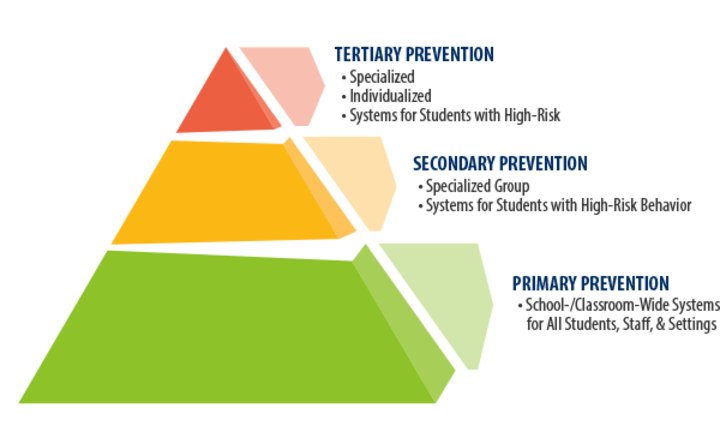
In medicine, mental health, and now in education, there are three generally accepted levels of prevention for various disorders or problems. Each of these levels represents ways that professionals can intervene in order to diminish problems in their clients. Here we will describe each level without technical jargon, and relate them to our purpose in schools, particularly focusing on student behavior. Most often these three tiers are graphically represented in a triangle diagram. However, these tiers may also be represented as concentric circles. The tiers may help prioritize the type and intensity of interventions for behavior that students receive. It is possible that any particular intervention can be used at any of these three tiers. What we have done on this website is identify the primary way strategies would be used.


Tier 1. The first level of intervention, called primary or universal prevention, is often called Tier 1 intervention in schools. Primary level interventions are delivered to all students, and attempt to undertake modifications in the environment or system which prevent behavior or mental health problems from developing. All students benefit from Tier 1 interventions in school. When Tier 1 interventions are implemented well, potentially fewer students will need additional services. Character education, a curricula intended to help all students understand and commit to behaviors that align with core ethical values, is an example of a Tier 1 intervention.

Tier 2. The secondary level of interventions in schools (now commonly called Tier 2) focuses on specific students who show initial signs or symptoms of difficulty. Data from these students is then used to provide targeted interventions to those "at-risk" students based on their specific needs and symptoms. Signs may include behavior management problems in class, tardiness, office referrals, absences, etc. In a total school population, it is estimated that 15 percent of students, might develop some form of behavioral difficulty and require Tier 2 supports in addition to all Tier 1 supports. Check-in/Check-out, a strategy used to monitor student progress and provide positive daily contact with an adult in school, is an example of a Tier 2 intervention.

Tier 3. Tertiary level interventions (Tier 3) focus on rehabilitation and minimizing the risk of recurrence of mental health problems or behavioral episodes for students who have already experienced one or more behavioral crises. These supports are the most intensive and resource dependent, and thus are reserved for the approximately 5 percent or less of students who do not respond to Tier 1 and 2 interventions. Again, students receiving Tier 3 supports must also receive all appropriate Tier 1 and Tier 2 supports. Conducting a functional behavior assessment (FBA) to determine the events preceding and following problem behavior, which is then used to create an individualized behavior plan, is an example of a Tier 3 intervention.
These three tiers of prevention, which inform interventions in schools, represent a useful framework for understanding how we can prevent behavioral crisis and make schools safer. Implementation of effective interventions at each of these three tiers would also prevent or diminish the need for physical restraint and seclusion.